Of Time and Turtles with Sy Montgomery
Air Date: Week of December 15, 2023
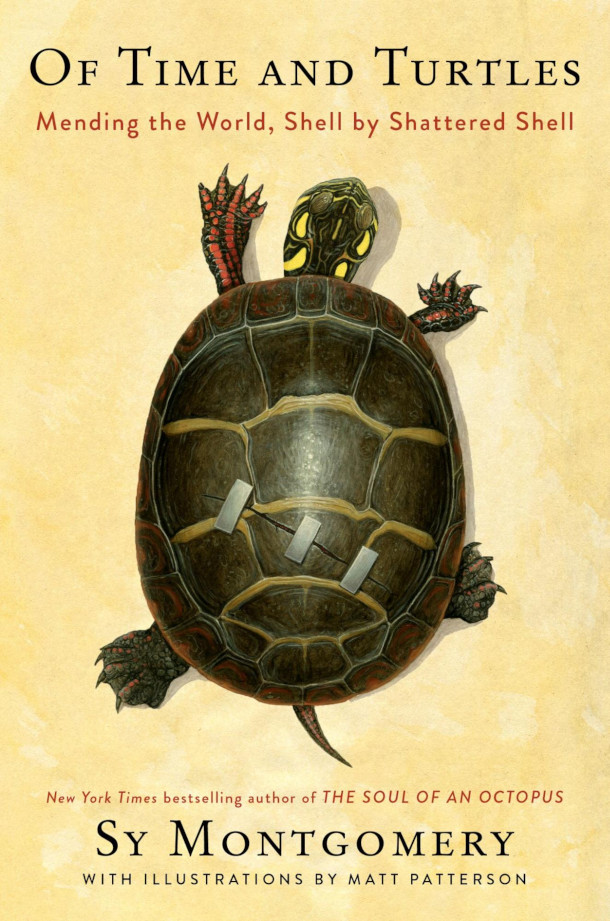
The cover of Of Time and Turtles: Mending the World, Shell by Shattered Shell by Sy Montgomery, with illustrations by Matt Patterson. (Photo Courtesy of HarperCollins, Illustration by © Matt Patterson)
Author and animal whisperer Sy Montgomery’s latest book, Of Time and Turtles: Mending the World, Shell by Shattered Shell features miraculous stories of recovery at a hospital for gravely injured turtles. Sy joined Host Steve Curwood in the NHPR studios to share these stories and discuss how these long-lived, ancient beings help illuminate the nature of time itself.
Transcript
O’NEILL: It’s Living on Earth, I’m Aynsley O’Neill
CURWOOD: And I’m Steve Curwood.
[MUSIC: Ziggy, “No More Words” on Finger Picked Poems, Artist Original]
CURWOOD: With me now is Sy Montgomery. Her latest book is called, Of Time and Turtles: Mending the World, Shell by Shattered Shell. Welcome back to Living on Earth, Sy!
MONTGOMERY: Oh, I'm so pleased to be here with you.
CURWOOD: This is an amazing book, and I have to tell people who can't see the cover, that it has, I think this is a painted turtle on the cover?
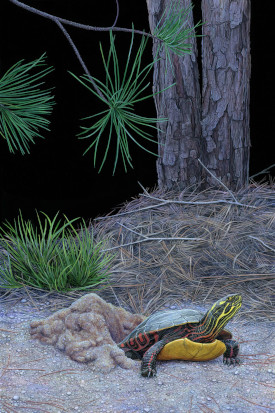
“Eastern Painted Nesting.” (Illustration by © Matt Patterson)
MONTGOMERY: It is.
CURWOOD: But the painted turtle's shell, has well kind of like a bandaid across it, because it's cracked. And it's a beautiful turtle, by the way, great colors, there's yellow, there's red, there's black, illustrated by your illustrator, right, Matt Patterson?
MONTGOMERY: Matt Patterson, who's also a major character in the book, and a real turtle savant.
CURWOOD: So, Sy, you've written so many books about many different kinds of creatures. In fact, upon your advice, I've gone looking for pink dolphins in the Amazon. I've spent some time with an octopus, Octavia. She was quite lovely.
MONTGOMERY: Oh, yes, she liked you.
CURWOOD: And then I've also learned about hawks, to my surprise. But for this book, what ignited your desire to spend time with turtles and write about them? I mean, tell us that story, please.
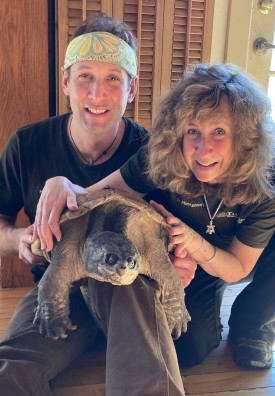
Matt Patterson and Sy Montgomery enjoy a cuddle with Fire Chief the snapping turtle. (Photo: Jeanne Urda)
MONTGOMERY: Well, I've always loved turtles. But it wasn't until about seven years ago when I met Matt Patterson that I started getting deeply into turtles. And Matt, as I said, is a real turtle aficionado. He considers himself a turtle artist. And we started doing "turtle-y" things together. Well, around this time, I had finished "The Soul of an Octopus," and was thinking about what would be my next big project that I would pour years of my life into? Well, having explored the philosophical question of consciousness in, "The Soul of an Octopus," for my next big book, I wanted to explore the philosophical question of time. Time is a mystery, just like consciousness. We wonder, you know, what is it? Is it real? Does it flow through us? Do we flow through it? What do we do with it? Who has it? And who better than turtles to help me understand time, these ancient creatures who evolved at the same time as the dinosaurs, who have great long lifespans, who have wisdom and who understand waiting. And little did I know that I would conduct this inquiry into the nature of time during the pandemic, when time stopped.
CURWOOD: Boy, it did, didn't it?
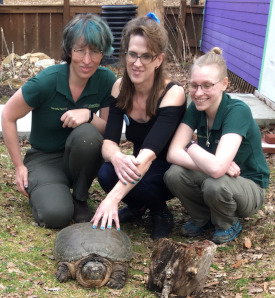
(Left to right) Natasha Nowick, Alexxia Bell, and Michaela Conder spend time with Bonaparte. (Photo: Sy Montgomery)
MONTGOMERY: Yeah. But it was a great time to know turtles, because turtles know ancient time, sacred time. They know the kind of time that isn't ruled by the calendar and the clock. In general, they don't hurry, they don't feel the sort of Damocles over their heads for deadlines. They get everything done when it needs to be done. And they drew me into a wholly different kind of time, the kind of time the Greeks called, "kairos," or sacred time. And you just cannot be with a turtle without feeling you're apprenticed to someone really wise. The oldest turtle on record that we know of only recently died at 288 years of age. So basically, you know, they don't seem to age. In fact, I think they kind of reverse age, because their shells tend to get smoother as they get older. And I don't know about you, but I'm not getting any smoother as I get older!
CURWOOD: It's radio, you can't see the wrinkles.
MONTGOMERY: [LAUGH]
CURWOOD: But this, this turtle that died at 288 years, let me do the math. The United States of America is only 250 or so years old. So this turtle was alive back when-
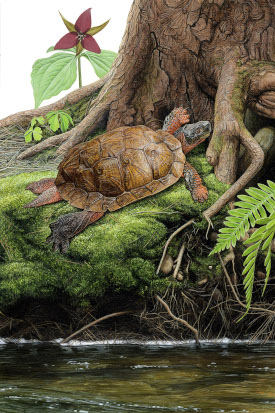
“Male Wood Turtle.” (Illustration by © Matt Patterson)
MONTGOMERY: When George Washington was roaming the earth. Yes.
CURWOOD: Interesting.
MONTGOMERY: They have so many ways of cheating death, you know. They have that wonderful shell, they can slow their bodies down to brumate or hibernate. They can breathe through their cloaca, they can breathe out of their butts if they need to do it, totally stopping their lungs. They have all kinds of superpowers.
CURWOOD: So you get into this volunteering at the Turtle Rescue League in Massachusetts, to help rehabbing, rehabilitating turtles. Paint a picture for us of what this place is like. You walk in, and you smell and you see what?
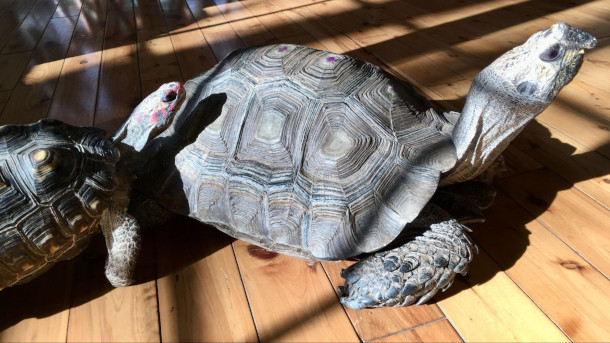
Pizza Man and Sprockets greet visitors at Turtle Rescue League. (Photo: Sy Montgomery)
MONTGOMERY: Wow. Well, the first thing that happens is that you notice it's unlike the other houses on the street, because it's this bright limey green, otherwise somewhat unremarkable, except parked in the front are two turtle ambulances complete with strobe light, and they say "Turtle Rescue League" on the back. So you knock on the door, and Alexxia Bell or Natasha Nowick will answer. The first time we went, we step over a knee high barricade. And what's that for? Well, we soon see the reason for the barricade, because this tortoise named Pizza Man is coming towards us, stomping towards us like a slow motion missile. He wants to be wherever the action is. And he came over, stood at my feet, looked in my face, and performed what was clearly a greeting. He whipped his head to the side, and then whipped it back to me, and then to the side, and then back, staring up into my face. And obviously, it was just like shaking someone's hand or giving someone a hug. And so, Sprockets and Pizza Man, Sprockets is another tortoise, even larger than Pizza Man, they pretty much have the run of the living room and kitchen. But downstairs in the basement is the turtle hospital, where somewhere between, depending on the time of year and how busy it is, 150, 250 maybe as many as a 1000 injured, hatchling, or abandoned turtles are kept in that hospital. And it kind of smells like a warm pond in the summer. And you hear the sound of water pumps, some of the turtles live in water, some of them don't. And they're all different species, some are exotic, some are natives. And everywhere you go, there is a turtle or a tortoise, who is recovering from something, either being abandoned, or having been hit by a car, or chewed by a dog, or hit by a lawn mower. Turtles come in there with some of the most horrendous injuries, you would think they were not survivable. But the first time Matt and I visited, we came away feeling as if we had been to Lourdes, because we saw slides of turtles who had come in, it was as if their organs had been smeared on the road, their shells were cracked, the eyes were missing, arms were broken, tails were off. You just think, they're a goner. But then, a few years later, their shells can heal. You need expert care and you need time. But some of these horrendous cases were released, healed, into the wild. And we had no idea that we'd be experiencing this during the pandemic. But it was just great to be not just witnessing, but actually part of these success stories, these fabulous happy stories of restoration and renewal, during that dark time.
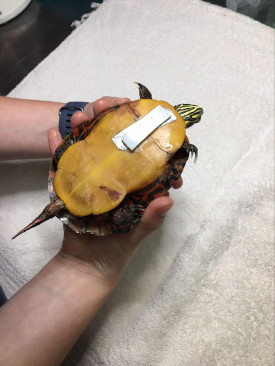
A painted turtle gets a patch for his broken plastron at Turtle Rescue League. (Photo: Sy Montgomery)
CURWOOD: The stories that you have of the healing of these turtles from, as you say, so many horrific injuries, it's more than miraculous. It's literally amazing.
MONTGOMERY: Yeah.
CURWOOD: And in the process, you learn yourself how you can help a turtle, because I think at one point you wind up with a baby turtle that, for all intents and purposes, looks dead. But then what do you do?
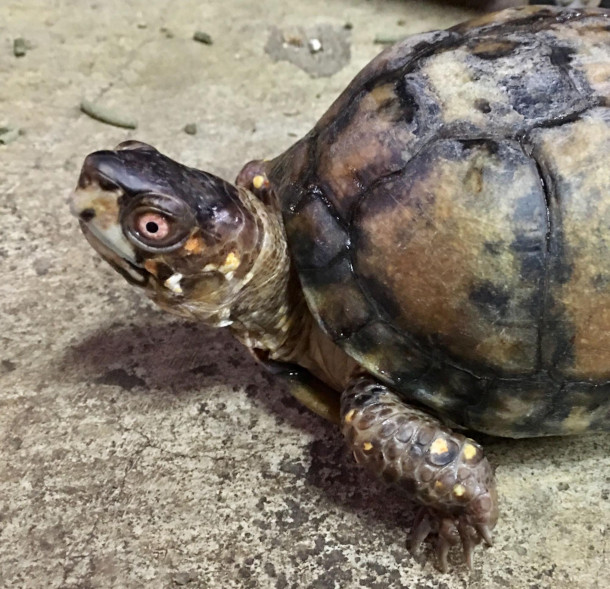
Percy is a centenarian box turtle who lives at Turtle Rescue League. (Photo: Sy Montgomery)
MONTGOMERY: Oh man. Well, on top of assisting Natasha and Alexxia at the hospital, we also raised, with a permit, baby turtles for release into the wild. And I had four baby painted turtles who I was raising up so that they would be a little bit larger than they otherwise would be and kind of have a head start. So these were painted turtles, so they were named Monet, Manet, Bernard and Seurat. So every morning I would turn on the heat lamp for them, make the sun rise, and see my baby turtles, and feed them. And one morning in February, I turned on the light and I only saw three of them. And Monet was like, missing. And freakishly, I discovered him in the detached sucker that held the floating dock to the side of the tank. And he had drowned. He was dead. His eyes were closed, and his neck was limp, and there was no sign that he was breathing. And since this was morning, he could have been there all night. But I remembered about turtle CPR. And this does not involve mouth to beak contact. You move their little arms and legs back and forth and back and forth. And what you're trying to do is start their heart and get their lungs pumping again. So, nothing was happening for the first minute or 10 minutes, or 15 or 30. But after 45 minutes, I saw his neck move. And he came back to life. And that spring, I was able to release him with his brethren. And in that way, a miracle happened in my hand, in our house.
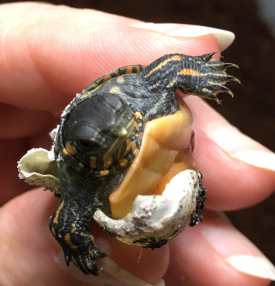
A hatchling painted turtle emerges from its egg. (Photo: Matt Patterson)
CURWOOD: And so now you are a turtle master.
MONTGOMERY: I don't think so! But anyone can do this. We can all be turtle heroes. And not only is it not difficult to bring a turtle back to life in this way. But when you cross a turtle, you're saving a life. And goodness. I mean, anytime you save any little animal, it's a wonderful thing to do. But turtles, most people don't realize, that they are the most endangered kind of vertebrate, there's over 350 kinds of turtles, but as a group, turtles are more endangered than any other creature with a backbone that lives on land in the entire world.
CURWOOD: Why is that?

This snapping turtle was named Robin Hood after he came in with an arrow through his neck. (Photo: Sy Montgomery)
MONTGOMERY: There's so many things against them. They are having all the problems everyone else is having. You know, habitat destruction, and roads, and climate disruption. With turtles climate disruption is particularly bad because sea turtles, the seven kinds of sea turtles, their entire beach might not be there anymore. Many turtles, not just sea turtles, but many turtles, the temperature of the nest determines the sex of the babies, not their genes. So if the temperature goes up a little bit, you're gonna get like, all females. And if it goes up a little more, you get boiled eggs. But on top of all of that, which is bad enough, there's this insidious trade, illegal trade, in turtles, for their meat, for their shells, and for pets. And they are really targeted. So they are vanishing fast. And over 61% of the existing turtle species in the world are endangered or threatened, and many of them are already extinct in the wild.
CURWOOD: So talk to me about the personalities of these turtles. On your book jacket, there's a picture of you and your Illustrator, Matt, and Fire Chief.
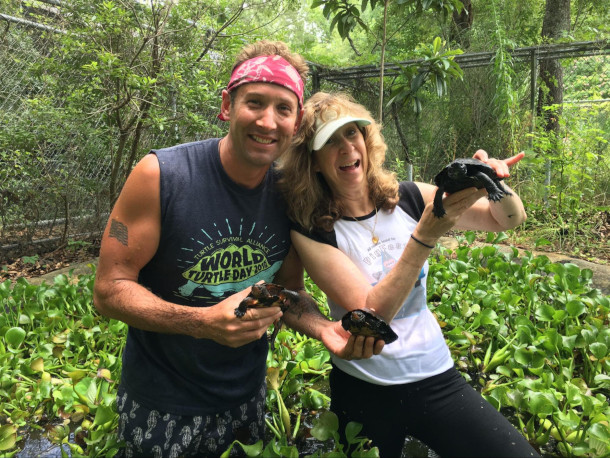
Matt and Sy spend time in a turtle pond at the Turtle Survival Alliance’s Turtle Survival Center in South Carolina. (Photo: Turtle Survival Alliance)
MONTGOMERY: Yes. Well, next time you're in Hancock, we got to introduce you to Fire Chief. He's really awesome. He is a 42 pound, adult male snapping turtle who is probably about my age. I'm 65. And we met him at Turtle Rescue League. He had been there for several years. So the first time I saw him, he was living in the hospital tank and Natasha opened up the lid to the tank and dropped in a banana. And I was amazed to see this huge head that looked like it was as big as my thigh, it wasn't, but this huge head come lurching out, like an estuarine crocodile, you know, eating a wildebeest in the crossing. So he was, he murdered that banana. And I thought man, this turtle, he is magnificent, but he's a little scary. Matt said, he has a wild appeal, because Matt is used to picking up giant snapping turtles all the time. So in 2018, he'd been hit by a car when he was crossing the road, from his summer pond to his winter pond. And his shell had been cracked, and it broke his spine. And his back legs and tail were paralyzed. But they can regenerate nerve tissue. So Natasha and Alexxia fixed him right up. And he was living in a hospital tank. And when Matt and I started volunteering there, one of our happiest tasks was, we were going to do physical therapy with a giant snapping turtle. So the first time we took him out for physical therapy, he's walking around outside for the first time since his accident, and his legs were really weak and our job was to help strengthen them. But what was so amazing was that very first time that we had him out, at one point we put him back down and just were sitting there with him. And Matt and I at the exact same moment, felt this urge to reach out and pet his head. And Alexxia and Natasha were kind of astounded and they thought, did you tell them they could do that? No. Did you tell them they could do that? And when we found out they were saying that to each other, we said, well, no, he told us we could do it. We just felt that he trusted us. And he did. And Fire Chief became a very good friend of ours. He is really gentle. He's not just a gentle snapper. He's a gentle animal. He's a real sweetheart. He's curious. He's focused. He's active. He's brave. And he's kind.
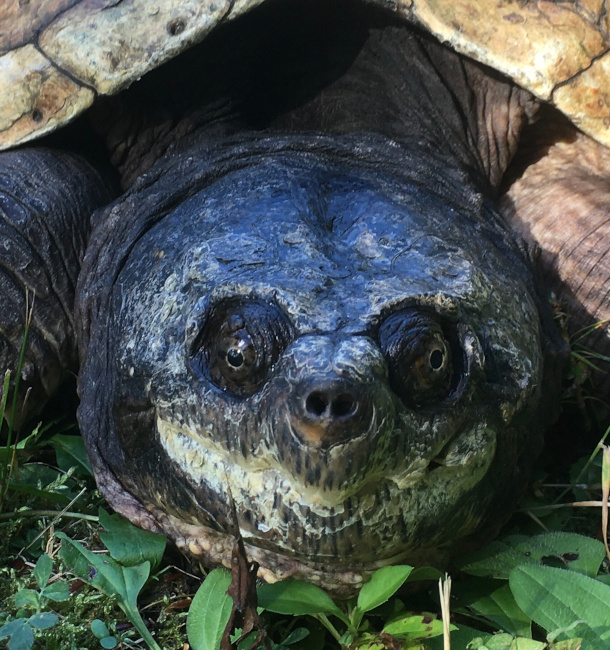
Fire Chief is a 42 pound snapping turtle. (Photo: Sy Montgomery)
CURWOOD: Great attributes. And by the way, how did he get that name, Fire Chief?
MONTGOMERY: Well, he used to live in a pond next to a fire station. And all the firemen knew him. But when he got hurt, the firemen loved him, you know they saw him every year. But these brave guys who run into the burning building to save you, they weren't brave enough to pick up a scary 42 pound snapping turtle. So they call these two skinny ladies, Natasha and Alexxia. And Natasha, by the way, is blind. And they come rushing out with the ambulance and with their kayak. They launch the kayak, Natasha stays in the kayak to receive the turtle, Alexxia jumps into the water and picks this guy up, who, of course, was not in a very good mood, because he just had a horrible accident. And they took him away just fine. So we still call him Fire Chief.
CURWOOD: So what was it like being with these turtles through the pandemic? I think at one point in your book, you describe getting on an airplane to go see turtles and you look around the plane, there's nobody there, because...
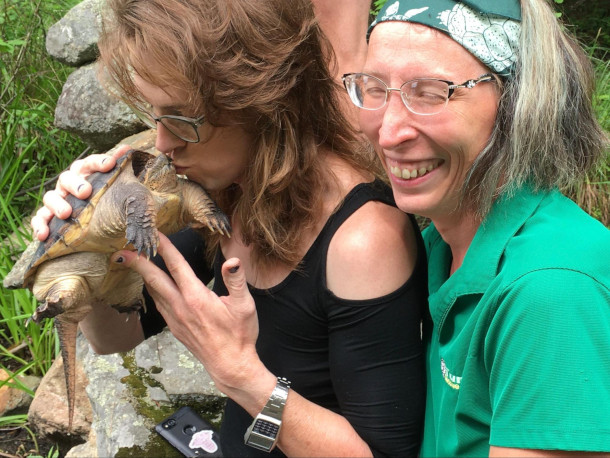
Alexxia sets Chutney free after his long rehabilitation. (Photo: Sy Montgomery)
MONTGOMERY: Yeah, this was the very beginning, before we knew of the emergency. We'd heard of some strange contagion that happened in China, but we didn't really think it was going to be a pandemic. And one of my first thoughts was like, oh, my gosh, am I still going to be able to carry out, you know, our volunteer work, but it seems natural to mask in a hospital. And a lot of our work happened outside. So that was just fine. But what was so helpful and healing to me and Matt, I think, was that during this time that it just felt like the whole world was broken into pieces, and it was not just the pandemic, there was, you know, all this, like, racial violence, and this terrible, catastrophic climate change was upon us. The world was on fire. Brazil was on fire, Australia was on fire, our forests were on fire, floods, it really felt like end times. But we had this job literally putting back together broken creatures. And when you're doing something, to mend to the world at a time the world feels broken, that is the way out. And being with creatures who are so strong, and who take the long view, being in the company of turtles, and watching and helping them heal, that was tremendously healing for us. On Election Day, which turned out to not be one day but three, as you remember, Matt and I were driving in, listening to the radio, we were so frustrated, we would just scream in the car. Well, we pulled up to the Turtle Rescue League, put on our masks, went down, started working with turtles, and we spent time with the Fire Chief. And the turtles just reconnected us to another reality. A reality that was gonna be there, no matter who won the election. No matter who won the election, no matter what was going on in our cities and streets, we could help this turtle. And because of that, our souls were mending, too.
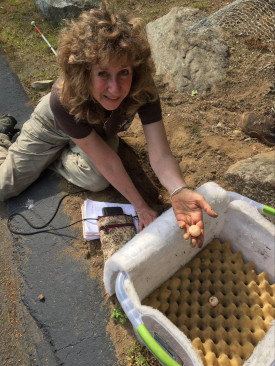
Sy rescues snapper eggs laid by the side of a parking lot. (Photo: Matt Patterson)
CURWOOD: There's a place on page 262, if you could read from, Sy. It's about time, and more.
MONTGOMERY: "In North America's Haudenosaunee, Lenape, and Abenaki creation stories, the Great Spirit creates the homeland by placing Earth on the back of a huge turtle. Many now still refer to North America as Turtle Island. And indeed, this is the continent boasting the most turtle species in the world. In China, the World Turtle is named Ao; the creator goddess uses Ao's legs to prop up the heavens. Without the turtle, we are told, the very sky would fall. Turtle wisdom reminds us that even at a moment in history that feels like the end times, we can find a way to regain our connection with creation--and like the World Turtle, take our turn upholding the earth. If we've used our time wisely, when we are ready, we can at last hand that joyous, terrible, honorable essential burden to the next generation, and the next, and the next, in a great cycle of renewal."
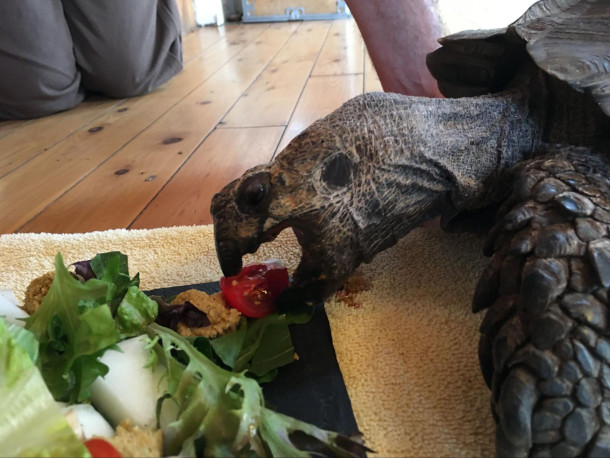
Sprockets, a Burmese Mountain tortoise, enjoys a tomato. (Photo: Sy Montgomery)
CURWOOD: Sy Montgomery's book is called, Of Time and Turtles: Mending the World, Shell by Shattered Shell. Sy, thanks for taking this time with us today.
MONTGOMERY: Nothing I'd rather be doing.
Links
“The Hawk’s Way” LoE Interview
Living on Earth wants to hear from you!
Living on Earth
62 Calef Highway, Suite 212
Lee, NH 03861
Telephone: 617-287-4121
E-mail: comments@loe.org
Newsletter [Click here]
Donate to Living on Earth!
Living on Earth is an independent media program and relies entirely on contributions from listeners and institutions supporting public service. Please donate now to preserve an independent environmental voice.
NewsletterLiving on Earth offers a weekly delivery of the show's rundown to your mailbox. Sign up for our newsletter today!
 Sailors For The Sea: Be the change you want to sea.
Sailors For The Sea: Be the change you want to sea.
 The Grantham Foundation for the Protection of the Environment: Committed to protecting and improving the health of the global environment.
The Grantham Foundation for the Protection of the Environment: Committed to protecting and improving the health of the global environment.
 Contribute to Living on Earth and receive, as our gift to you, an archival print of one of Mark Seth Lender's extraordinary wildlife photographs. Follow the link to see Mark's current collection of photographs.
Contribute to Living on Earth and receive, as our gift to you, an archival print of one of Mark Seth Lender's extraordinary wildlife photographs. Follow the link to see Mark's current collection of photographs.
 Buy a signed copy of Mark Seth Lender's book Smeagull the Seagull & support Living on Earth
Buy a signed copy of Mark Seth Lender's book Smeagull the Seagull & support Living on Earth

